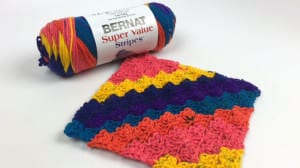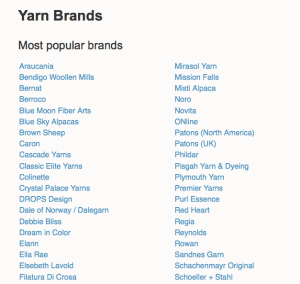
What Are the Brand Equivalents?
We are generally asked what the substitutions of yarn are for outside of Canada / USA for patterns and videos that we feature.
Truthfully, I don't know the answer first hand and turned to The Crochet Crowders to help us comprise a list of substitutes. The information below is information that was shared to us. Most of the responders directed me to Ravelry as this information is there.
While Yarnspirations does ship beyond the Canadian and USA borders to other regions of the world, other yarn companies do not. It's up to the retailers to stock the yarn in other countries and those locations are unknown to me.
The biggest difference between the yarns across the world is the thickness. While most, if not all, yarn companies here in North America following the Yarn Craft Council Standards. This council is about creating the standards so that yarn balls fall into a class of weight which is usually contributed by the thickness of the yarn.
Here in North America, many of us use 4 Ply Worsted by the plies can be different thicknesses. For example, I've come to understand that in another country, the equivalent can be a 12 ply. It just means that their starting plies are much thinner if 12 plies of one yarn can equal 4 plies of another.
You Get What You Pay For
Acrylic yarns can vary from brand to brand as well as company to company. There is value acrylic and premium acrylic. The difference to you and I is the softness. Sometimes I can be cheap and expect champagne on a beer budget.
Mixing the blends of yarns with animal fibers, unnatural materials or acrylic can change the look, feel and strength. It's all relative.
The materials of the yarn can mean the difference of a yarn colour being vibrant, long lasting and can impact the retail shelf value.
For example, variegated yarn is usually less yardage per ball verses a solid colour ball in the same yarn line. Companies package the yarn to a certain price point. There is a considerable amount of extra labour involved in making variegated yarn verses the solid colour yarn. This change of packaging from solid to variegated allows a retailer to put the entire brand as one price instead having the solid balls set at $5 and variegated is set to $7 for the same yardage. People have a sense they are being ripped off, when in fact, it takes an average of 8 additional hours of dying, drying and packaging to make a variegated ball. The retail price is dictated by the wholesale costs which factors in manufacturing processes and labour involved in making a product.
Find A Substitution

A website by the name of Yarn Sub has detailed information on yarn substitutions. It's probably the most comprehensive yarn substitution lists I have ever seen.
How It Works
- Go to YarnSub.
- Select the brand of the yarn.
- A new list appears of all of the yarns under the brand. Select the yarn line under the brand.
- The next page will show you the brand information you are looking to match. Then it will show you all the closest matches. There is more information such as price point and much more.
Samantha says
Yarnsub is good for the actual yarn, i.e. fiber content, yardage,etc., but it doesn't do anything for color. I would love to have a place to enter a specific color in a specific brand & style and be give suitable matches in other brands & styles. For example, enter Stylecraft Special DK in Wisteria and be given a list like Yarnsub does for the actual yarn.
Lene says
The yarn sub website is good... to a certain degree. It is very us- and uk-centric. A lot of the yarns it suggests, are just as unavailable here as the original american yarns. But it is helpful. In my country the weight numbering system is seldom used, except for the newer stores with online sales (Hobbii, Rito, Yarnliving). I really like that system, it is such a big help. I have bought from yarnspirations, but it is riddiculously expensive with international shipping, VAT, importtax and handling fees. 5 $ for a skein of yarn? I wish! It becomes much more before it gets to me. Finding yarn substitutions closer to home is cheaper.
Mikey says
Living in Canada, the number of yarn varieties that the USA has access to is mind-blowing. The retail space of shopping isn't as vast in Canada. So it's either order online or go without. It's a problem with being in a global space, people around the entire globe want access to things because they can see what they are missing. Back in the 80's and 90's, you only knew what your local friends knew and see the choices at the yarn shop totally unaware of choices that are out there. It's one of the hardest things about The Crochet Crowd is trying to appease the globe when the yarns are limited. Yes, shipping can be expensive. I try not ordering anything from the USA as the cross border tax is astounding and in many cases, depending on what I order, is higher than the product itself.
Moira says
Wow! I am such a visual learner and learning first by reading a chart is for me! I am an avid seamstress and always use cut out paper patterns, even when I make things with wood. Have you ever used a paper pattern to create a crocheted item? I notice that some charted crochet patterns have full-sized printable paper patterns as well. How are these full-sized patterns used?
Mikey says
I'm really not sure. I've never heard of anyone doing that for crochet but it seems to make sense.